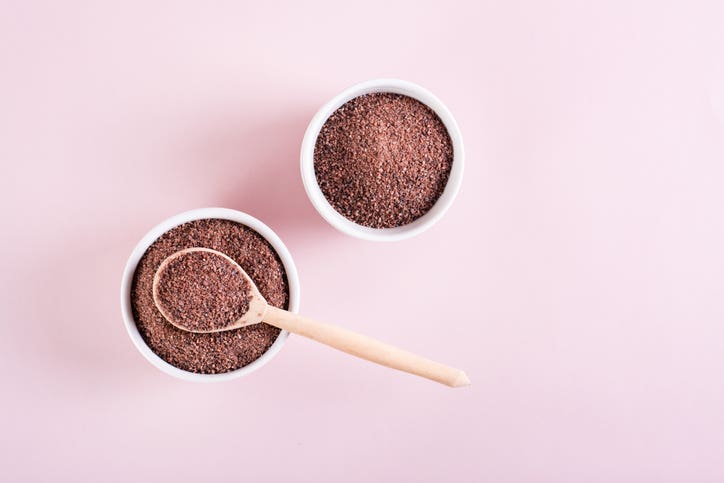
Why Vegan Cooks Swear by Kala Namak (aka Black Salt) for Adding Eggy Flavor Without Eggs
- Kala namak (Himalayan black salt) is prized in vegan cooking for its strong eggy aroma and flavor, thanks to sulfur compounds like hydrogen sulfide.
- It’s best to use it sparingly—a little goes a long way—and can enhance dishes like tofu scrambles, vegan mayo, dressings, and other “egg”-style recipes. Read on for the full guide.
Most vegan egg replacements of yore did a good job mimicking eggs’ look and consistency but lacked the rich umami flavor that eggs impart. Nowadays, plant-based cooks are turning to kala namak, or Himalayan black salt, to give everything from tofu scrambles to vegan mayonnaise a distinctively eggy edge. “If you’ve ever missed the taste of egg, or just that savory depth eggs can add to a dish, kala namak is worth trying,” says renowned vegan cookbook author and chef Isa Chandra Moskowitz, who pioneered the use of kala namak in vegan recipes over 20 years ago. “It’s one of those ingredients that can really transform something simple, like a tofu scramble or creamy carbonara, into something familiar and satisfying. Just a pinch adds a little spark that might be exactly what you’ve been missing.”
But it’s not just for eggy flavor: “I love kala namak on avocado toast, stirred into tahini or ranch dressing, and as a finishing touch on curries and tomato-based stews,” says Moskowitz. “It works in some unexpected places too, like fruit salad with lime and chili, warm potato salad, or a pinch on roasted chickpeas or to finish a savory salad. I’ve even added it to the rim of a virgin Bloody Mary, where it really brings out the savory notes. It’s not something I use every day, but when I want that savory depth and a little somethin’ somethin’, it adds a flavor nothing else quite does.”
Here’s everything you need to know to start using kala namak with confidence in your own cooking, whether it’s a new ingredient for you or you’re already a fan.
What Is Kala Namak?
Kala namak, which means “black salt” in Hindi or Urdu, is a popular seasoning salt in Northern India and Pakistan, where it is used to flavor chaats (spicy, savory snacks), raita sauce, chutneys, and cooling drinks.
Kala namak is made by roasting mined rock salt with fruits and herbs at high temperatures in a wood-fired kiln until the salt crystals fuse and turn a dark purplish black. When kala namak is ground, its color pales to a brownish-pink—which can make the Western name, “black salt,” a bit confusing.
Kala Namak vs. Other Black Salts
To add to the confusion, there are other types of black salt on the market that are nothing like kala namak. Most of them, including Hawaiian black salt or lava salt and Mediterranean black salts, are sea salts that have been combined with activated carbon to produce large, dramatically hued crystals. Some black salts made in Greece are colored with squid ink. These salts taste like regular table salt. with only subtle differences, whereas kala namak has a strong, distinct flavor and aroma all its own.
Kala Namak’s Taste and Aroma
Pungent is the first word that comes to mind to describe kala namak. Its egg-like aroma is due to the salt’s sulfur compounds, including hydrogen sulfide, the same substance that gives eggs their distinctive smell when cooked. “Kala namak is strong stuff, especially if you’ve never smelled or tasted it before,” cautions Moskowitz. “Don’t be alarmed by the smell in the package. The sulfur can be pretty intense, but it softens a lot once it’s in food.”
Kala namak’s intense flavor has another benefit, according to Moskowitz. “I find that when I use kala namak, I don’t need to add as much regular salt or I can skip additional salt altogether,” she explains. “It’s not exactly a salt substitute, more like a salt with a very specific personality that can help keep sodium lower while still delivering strong flavor.”
Shopping and Storage
Moskowitz recommends buying finely ground kala namak. If you buy the larger, darker crystals, you’ll need to use a mortar and pestle to grind them down.
“Kala namak does not really ever go bad but over time, the sulfur smell will fade,” says Fiona Kennedy, product development chef for salt and seasoning purveyor The Spice Lab. “Store it in an airtight container, preferably glass, in a cool, dark place. Avoid storing it in plastic as the smell may leach out and scent your whole cabinet!”
How to Use Kala Namak
Try kala namak is any vegan variation on a savory egg dish, including scrambles, frittatas, quiche, or vegan egg salad. Moderation is key with kala namak. “A little goes a long way, probably more than most salts,” says Moskowitz. “When I cook with it, I use a light touch then see what else is needed to finish.”
“Kala namak is mostly used at the end of cooking or as a finishing salt,” says Kennedy. “But if the smell is too strong for you, adding it to a dish at the start of the cooking process will help to tame the sulfur flavor and make it much more subtle.”
In terms of amounts, start with ⅛ to ¼ teaspoon in a recipe or sprinkled on at the end, then adjust based on your preference.
A note on sodium: Ground kala namak contains about 1,680 milligrams of sodium per teaspoon—slightly less than the 2,300 milligrams found in the same measure of regular table salt. Still, it’s best to use it sparingly, especially if you’re watching your sodium intake.
Recipes to Try
These healthy vegan recipes leverage the pungent power of kala namak.
- Dom Thompson’s Vegan Egg Salad Collard Wraps
- Tortilla Española with Potatoes and Red Peppers
- Scrambled Tofu Casserole with Mushrooms and Spinach
- Potato-Spinach Casserole with Trumpet Mushrooms
- Creamy Corn Dressing with Dill and Chives
You might also incorporate a little kala namak into our Quiche Florentine with Artichoke Hearts, Chickpea Omelet, and Vegan Mayo recipes.
About the Author

About the Author
Mary Margaret Chappell
Join our mailing list
Get free recipes and the latest info on living a happy, healthy plant-based lifestyle.
By providing your email address, you consent to receive newsletter emails from Forks Over Knives. We value your privacy and will keep your email address safe. You may unsubscribe from our emails at any time.
